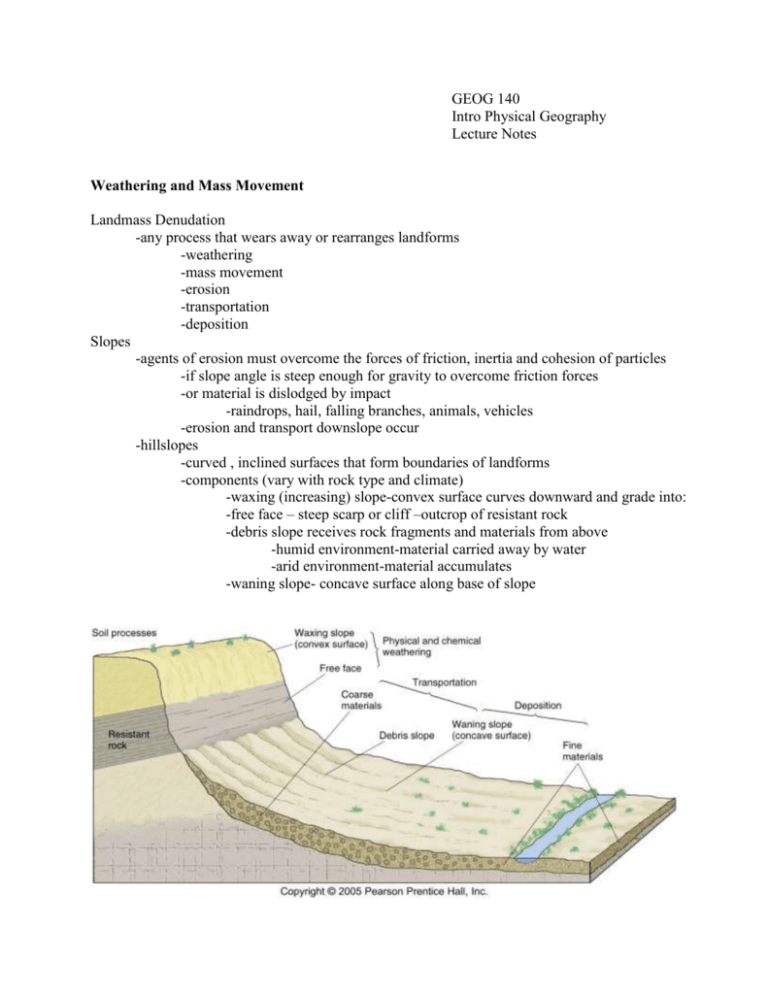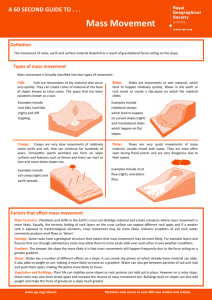Weathering and Mass Movement
advertisement

GEOG 140 Intro Physical Geography Lecture Notes Weathering and Mass Movement Landmass Denudation -any process that wears away or rearranges landforms -weathering -mass movement -erosion -transportation -deposition Slopes -agents of erosion must overcome the forces of friction, inertia and cohesion of particles -if slope angle is steep enough for gravity to overcome friction forces -or material is dislodged by impact -raindrops, hail, falling branches, animals, vehicles -erosion and transport downslope occur -hillslopes -curved , inclined surfaces that form boundaries of landforms -components (vary with rock type and climate) -waxing (increasing) slope-convex surface curves downward and grade into: -free face – steep scarp or cliff –outcrop of resistant rock -debris slope receives rock fragments and materials from above -humid environment-material carried away by water -arid environment-material accumulates -waning slope- concave surface along base of slope -slopes seek angle of equilibrium -optimum incline that balances conflicting forces Physical Weathering Processes -destruction of rocks through various stresses -makes more surface area available to chemical processes -frost action (frost wedging) -water in cracks and pores of rocks expands with freezing (up to 9% increase in volume) and contracts with thawing -rock fragments can remain in place for erosion by water or wind or they can roll or fall down slope -scree slope or talus cone -important process in humid continental, subarctic, polar and highland climates -crystallization (salt crystal growth) -pressures similar to ice expansion -found in arid environments -water drawn to surface of rocks through evaporation -dissolved minerals grow crystals -hydration -water combining with minerals -minerals expand and contract forcing grains apart -works with carbonation and oxidation to convert feldspar to clay minerals -pressure-release jointing -removal of overlying layers releases pressure and allows rocks such as granite to peel apart layer by layer (sheeting and exfoliation) -organic physical weathering (root wedging) Chemical Weathering -hydrolysis -moistening of minerals causes alteration (not present in hydration) and expansion in volume contributing to breakdown of rocks -oxidation -caused through exposure to oxygen in the atmosphere -dominant weathering mechanism in the tropics -removal of iron from rocks disrupts crystal structure and makes rock more susceptible to further chemical weathering and disintegration -carbonation and solution -mineral dissolves into solution -carbon dioxide and water create carbonic acid -acid strong enough to react with many minerals especially limestone -Geography of Weathering -different climatic zones have different dominant weathering processes -cold climates -physical/mechanical weathering (ice wedging) dominates -humid climates -abundance of water-chemical weathering dominates -arid environments -physical/mechanical more important-chemical less so -Classes of Mass Movements -Four basic types of movement -fall -slide -flow -creep -Falls and Avalanches -fall -downward movement of rock (rarely soil) through the air -soil doesn't usually form on very steep slopes or cliff faces required for free fall -exception-toppling of slabs of earth along river banks -bank calving due to undercutting of banks -rockfalls (frost action, pressure release) -common in areas with terrain composed of high, steep rock slopes and cliffs -size of material varies -small rock fragments to large blocks -material spread over extensive area unless confined by topography -talus slopes -large rockfalls often transformed into debris avalanches after initial impact -debris avalanche -falling and tumbling rock, debris, and soil -higher rate of speed than debris slide or landslide -ice and water fluidize debris -Landslides -take place along a plane of weakness -two basic forms -translational (rockslide) -rotational (slump blocks) -rockslide -rapid movement of rock material along a bedding plane or other plane of structural weakness -can move as a large block for a short distance -often break up into smaller material -often on steep mountain fronts but also on slopes w/gradients as little as 15° -among the most catastrophic forms of mass movement -millions of metric tons in a few seconds -debris slide-rapid movement soil & loose rock fragments -slump blocks -mass that moves down a curved slip face (shear plane-concave-up) -rotational movement -upper portion tilted backwards -can move as a single block -usually broken into several segments -debris flow can occur at the end of a slump block -Flow -occurs throughout a moving mass; no defined shear plane or rupture where movement occurs -mudflows -type of debris flow consisting of large percentage of silt and clay sized particles -result from heavy rain or sudden thaw -water content up to 30% -high water content results in tendency of flow to follow existing drainages -common in arid and semi-arid regions -abundant loose, weathered debris -spread out into a lobe or fan as they reach open areas at mountain fronts -earthflows -less water -material slumps away from top (subsiding motion with backward rotation) -leaves a step-like terrace bounded by a curved wall-like scarp -in a slow flow the sluggish movement forms a bulging toe -Creep -slow movement of soil and regolith (rock material at base of soil profile) -repeated lifting (at right angles to slope) and falling (straight down) of individual particles -causes -heating and cooling of soil -growth of frost needles -wetting and drying -trampling and burrowing of animals -vibrations and earthquakes -effects -bulges or wavelike swells in soil -bending of strata -tilted trees and posts







